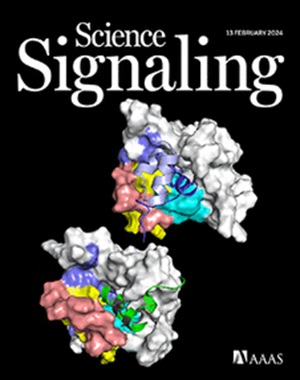Wild-type RAS signaling is an essential therapeutic target in RAS-mutated cancers
IF 6.6
1区 生物学
Q1 BIOCHEMISTRY & MOLECULAR BIOLOGY
引用次数: 0
Abstract
Mutated RAS proteins activate downstream effector pathways (RAF-MEK-ERK and PI3K-AKT) to drive oncogenic transformation and progression. Because RAS family members differentially engage these pathways, combined inhibition of both pathways is required to effectively treat RAS-mutated cancers. Here, we found that this was due to signaling contributed by wild-type RAS family members that activated an effector pathway that was poorly engaged by the mutant RAS family member. Wild-type KRAS and NRAS promoted RAF-MEK-ERK signaling in cells expressing mutant HRAS, whereas wild-type HRAS and NRAS promoted PI3K-AKT signaling in cells expressing mutant KRAS. Combining inhibitors targeting the poorly engaged RAS effector pathways with inhibitors targeting the mutant RAS resulted in synergistic cytotoxicity in a manner that depended on wild-type RAS expression. The farnesyltransferase inhibitor tipifarnib blocked mutant HRAS-PI3K signaling and synergized with MEK inhibitors in HRAS-mutated cells, whereas KRASG12C inhibitors blocked mutant KRAS-MEK signaling and synergized with PI3K inhibitors in KRASG12C-mutated cells. Synergy was abolished in MEFs lacking all RAS proteins and in cancer cell lines in which nonmutated RAS family members were deleted. Our data highlight the critical role of wild-type RAS family members in supporting mutant RAS signaling and its importance as a therapeutic cotarget in RAS-mutated cancers.
野生型RAS信号是RAS突变癌症的重要治疗靶点。
突变的RAS蛋白激活下游效应通路(RAF-MEK-ERK和PI3K-AKT)来驱动致癌转化和进展。由于RAS家族成员参与这些途径的方式不同,因此需要联合抑制这两种途径才能有效治疗RAS突变的癌症。在这里,我们发现这是由于野生型RAS家族成员提供的信号,激活了突变RAS家族成员很少参与的效应通路。野生型KRAS和NRAS在表达突变型KRAS的细胞中促进RAF-MEK-ERK信号传导,而野生型HRAS和NRAS在表达突变型KRAS的细胞中促进PI3K-AKT信号传导。将靶向低接合RAS效应通路的抑制剂与靶向突变RAS的抑制剂联合使用,以依赖于野生型RAS表达的方式产生协同细胞毒性。法尼基转移酶抑制剂tipifarnib阻断突变体HRAS-PI3K信号并与hras -突变细胞中的MEK抑制剂协同作用,而KRASG12C抑制剂阻断突变体KRAS-MEK信号并与KRASG12C突变细胞中的PI3K抑制剂协同作用。在缺乏所有RAS蛋白的mef和删除非突变RAS家族成员的癌细胞系中,协同作用被取消。我们的数据强调了野生型RAS家族成员在支持突变RAS信号传导中的关键作用,以及它作为RAS突变癌症治疗的共同靶点的重要性。
本文章由计算机程序翻译,如有差异,请以英文原文为准。
求助全文
约1分钟内获得全文
求助全文
来源期刊

Science Signaling
BIOCHEMISTRY & MOLECULAR BIOLOGY-CELL BIOLOGY
CiteScore
9.50
自引率
0.00%
发文量
148
审稿时长
3-8 weeks
期刊介绍:
"Science Signaling" is a reputable, peer-reviewed journal dedicated to the exploration of cell communication mechanisms, offering a comprehensive view of the intricate processes that govern cellular regulation. This journal, published weekly online by the American Association for the Advancement of Science (AAAS), is a go-to resource for the latest research in cell signaling and its various facets.
The journal's scope encompasses a broad range of topics, including the study of signaling networks, synthetic biology, systems biology, and the application of these findings in drug discovery. It also delves into the computational and modeling aspects of regulatory pathways, providing insights into how cells communicate and respond to their environment.
In addition to publishing full-length articles that report on groundbreaking research, "Science Signaling" also features reviews that synthesize current knowledge in the field, focus articles that highlight specific areas of interest, and editor-written highlights that draw attention to particularly significant studies. This mix of content ensures that the journal serves as a valuable resource for both researchers and professionals looking to stay abreast of the latest advancements in cell communication science.
 求助内容:
求助内容: 应助结果提醒方式:
应助结果提醒方式:


